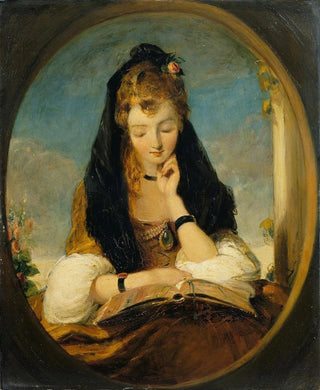Art print | L'étudiant doux - Gilbert Stuart Newton


View from behind

Frame (optional)
In the vast panorama of art history, certain works stand out for their ability to capture deep emotions and evoke intimate reflections. "L'étudiant doux" by Gilbert Stuart Newton is one of those pieces that, through its elegance and tenderness, invites the viewer to immerse themselves in a universe where human sensitivity is highlighted. This painting, depicting a young man in a moment of contemplation, resonates with a delicacy that transcends time. The light caressing the protagonist's face, the pastel colors subtly intertwined, and the pensive expression animating this character—all create an atmosphere imbued with serenity. Approaching this artwork, one cannot help but feel a connection with the artist's soul, an invitation to explore the intricacies of thought and reflection.
Style and uniqueness of the work
Gilbert Stuart Newton's style is characterized by a romantic and delicate approach, where every detail seems carefully thought out to create visual harmony. In "L'étudiant doux," the composition is skillfully balanced, highlighting the young man at the center of the canvas, while the surrounding elements subtly enrich the visual narrative. The nuances of color, ranging from soft shades to more pronounced contrasts, contribute to creating an intimate atmosphere. The use of light, in particular, plays a crucial role, emphasizing facial features and accentuating the expression of melancholy and dreaminess. This work does not merely depict a frozen moment; it evokes a story, a reflection, a quest for meaning that resonates with each of us. Newton's technical mastery, combined with his artistic sensitivity, makes this painting a masterpiece worth contemplating with attention.
The artist and his influence
Gilbert Stuart Newton, born in 1794, was an artist whose career was marked by a constant pursuit of authenticity and emotional depth. Trained within the artistic circles of his time, he managed to establish himself through a style that combines romanticism and realism. His influence extends beyond his own creations, inspiring

Matte finish

View from behind

Frame (optional)
In the vast panorama of art history, certain works stand out for their ability to capture deep emotions and evoke intimate reflections. "L'étudiant doux" by Gilbert Stuart Newton is one of those pieces that, through its elegance and tenderness, invites the viewer to immerse themselves in a universe where human sensitivity is highlighted. This painting, depicting a young man in a moment of contemplation, resonates with a delicacy that transcends time. The light caressing the protagonist's face, the pastel colors subtly intertwined, and the pensive expression animating this character—all create an atmosphere imbued with serenity. Approaching this artwork, one cannot help but feel a connection with the artist's soul, an invitation to explore the intricacies of thought and reflection.
Style and uniqueness of the work
Gilbert Stuart Newton's style is characterized by a romantic and delicate approach, where every detail seems carefully thought out to create visual harmony. In "L'étudiant doux," the composition is skillfully balanced, highlighting the young man at the center of the canvas, while the surrounding elements subtly enrich the visual narrative. The nuances of color, ranging from soft shades to more pronounced contrasts, contribute to creating an intimate atmosphere. The use of light, in particular, plays a crucial role, emphasizing facial features and accentuating the expression of melancholy and dreaminess. This work does not merely depict a frozen moment; it evokes a story, a reflection, a quest for meaning that resonates with each of us. Newton's technical mastery, combined with his artistic sensitivity, makes this painting a masterpiece worth contemplating with attention.
The artist and his influence
Gilbert Stuart Newton, born in 1794, was an artist whose career was marked by a constant pursuit of authenticity and emotional depth. Trained within the artistic circles of his time, he managed to establish himself through a style that combines romanticism and realism. His influence extends beyond his own creations, inspiring






